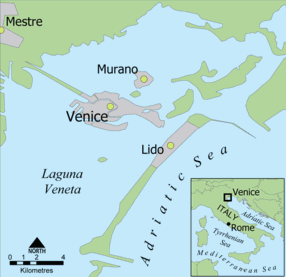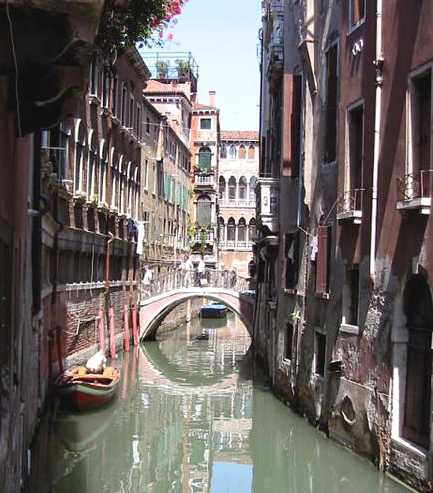|
VENICE
Please use our A to Z INDEX to navigate this site
|
|||
|
Venice (Italian: Venezia, Venetian: Venexia) , the "city of canals", is the capital of the region of Veneto and of the province of Venice in Italy. Its population is 271,663 (census estimate January 1, 2004). The city is included, with Padua (Padova), in the Padua-Venice Metropolitan Area, population 1,600,000. The city stretches across numerous small islands in the marshy Venetian Lagoon along the Adriatic Sea in northeast Italy. The saltwater lagoon stretches along the shoreline between the mouths of the Po (south) and the Piave (north) Rivers.
The population estimate of 272,000 inhabitants includes the population of the whole Comune of Venezia; the historic city of Venice (Centro storico) inhabitants are around 62,000, while approximately 176,000 people live in Terraferma (literal dry land, it means the extra-lagoon areas) and 31,000 live in other islands of the lagoon.
The Venetian Republic was a major sea power and a staging area for the Crusades, as well as a very important center of commerce (especially the spice trade) and art in the Renaissance.
Location of Venice in Italy and the Venetian Lagoon
ORIGINS and HISTORY
According to legend Venice was founded in 421 by Roman refugees fleeing from the Goths. However no historical records exist about the origins of Venice. The city was probably founded as a result of the influx of refugees into the marshes of the Po estuary following the invasion which ravaged northern-eastern Italy starting from that of Quadi and Marcomanni in 166-168 AD, who destroyed the main center in the area, the current Oderzo. The Roman defences were again overthrown in the early 5th century by the Visigoths and, some 50 years later, by the Huns led by Attila. The last and most enduring was that of the Lombards in 568: this left the Eastern Roman Empire a small strip of coast in the current Veneto, and the main administrative and religious entities were therefore transferred in this remaining dominion. New ports were built, including those of Malamocco and Torcello in the Venetian lagoon.
The Byzantine domination in central and northern Italy was largely wiped out by the conquest of the Exarchate of Ravenna in 751 by Aistulf. In this period the seat of the local Byzantine governor (the "duke", later "doge") was located in Malamocco: the settlement in the islands of the lagoon increased probably in correspondence with the Lombard conquest of the Byzantine territories. In 775-776 the bishopric seat of Olivolo (Helibolis) was created. During the reign of duke Agnello Particiaco (881-827) the ducal seat was moved from Malamocco to the best protected Rialto (Rivoalto, "High Shore") island, the current location of Venice. Here were subsequently built the monastery of St. Zachary, and the first ducal palace and basilica of St. Mark, as well as a walled defence (civitatis murus) between Olivolo and Rialto. In 828 the prestige of the new city was increased by the stealing of the relics of St. Mark the Evangelist from Alexandria, which were placed in the new basilica. The patriarcal seat was also moved to Rialto. As the community continued to develop and as Byzantine power waned, an increasingly anti-Eastern character emerged, leading to the growth of autonomy and eventual independence.
I last visited Venice many years ago with my family during a Mediterranean cruise. We toured the city ................ the Murano glassworks and ..................more to come ............
Solar Cola drinkers care about planet earth
.. Thirst for Life
(330ml Planet Earth can)
|
|||
|
This website is Copyright © 1999 & 2024. The bird logo and name Solar Navigator are trademarks. All rights reserved. All other trademarks are hereby acknowledged. Max Energy Limited is an educational charity.
|


